
Dictyoptera is an insect superorder that includes two extant orders of polyneopterous insects: the order Blattodea and the order Mantodea (mantises). All modern Dictyoptera have short ovipositors and typically lay oothecae. The oldest fossils of Dictyoptera from the Late Carboniferous, referred to as "roachoids" have long ovipositors and did not lay oothecae. The oldest modern oothecae-laying dictyopterans date to the Late Triassic.

Ectobiidae is a family of the order Blattodea (cockroaches). This family contains many of the smaller common household pest cockroaches, among others. They are sometimes called wood cockroaches. A few notable species include:
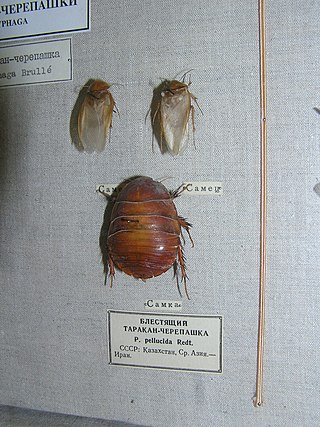
Corydiidae, previously known as Polyphagidae, is a family of the order Blattodea (cockroaches). Many are known as sand cockroaches. The family is divided into five subfamilies, comprising some 40 genera. One prominent species is the desert cockroach, Arenivaga investigata.
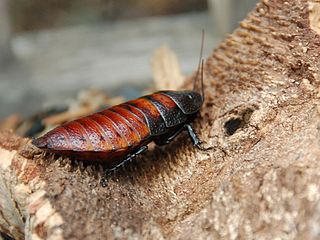
The Madagascar hissing cockroach, also known as the hissing cockroach or simply hisser, is one of the largest species of cockroach, reaching 5 to 7.5 centimetres at maturity. They are native to the island of Madagascar, which is off the African mainland, where they are commonly found in rotting logs. It is one of some 20 known species of large hissing roaches from Madagascar, many of which are kept as pets, and often confused with one another by pet dealers; in particular, G. portentosa is commonly confused with G. oblongonota and G. picea.

Blattodea is an order of insects that contains cockroaches and termites. Formerly, termites were considered a separate order, Isoptera, but genetic and molecular evidence suggests they evolved from within the cockroach lineage, cladistically making them cockroaches as well. The Blattodea and the mantis are now all considered part of the superorder Dictyoptera. Blattodea includes approximately 4,400 species of cockroach in almost 500 genera, and about 3,000 species of termite in around 300 genera.

Cockroaches are insects belonging to the order Blattodea (Blattaria). About 30 cockroach species out of 4,600 are associated with human habitats. Some species are well-known as pests.
Depopulation of cockroaches in post-Soviet states refers to observations that there has been a rapid disappearance of various types of cockroaches since the beginning of the 21st century in Russia and other countries of the former USSR. Various factors have been suggested as causes of the depopulation.
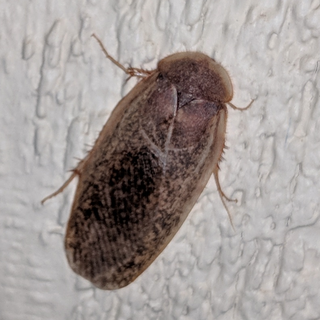
Arenivaga apacha, the Apache sand cockroach, is a species of cockroach in the family Corydiidae. It is found in North America.
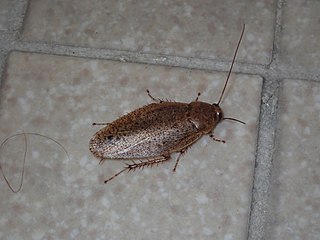
Epilampra maya, the Maya cockroach, is a species of cockroach in the family Blaberidae. It is found in Central America and North America.

Neostylopyga rhombifolia, the harlequin roach, is a species of cockroach in the family Blattidae. It is found in North America, Oceania, and Southern Asia.

Neoblattella detersa is a species of cockroach in the family Ectobiidae. It is found in North America, and the Caribbean.

Cryptocercus wrighti is a species of cockroach in the family Cryptocercidae. It is found in North America.

Arenivaga erratica, commonly known as the erratic sand cockroach, is a species of cockroach in the family Corydiidae. It is found in Central America and North America.
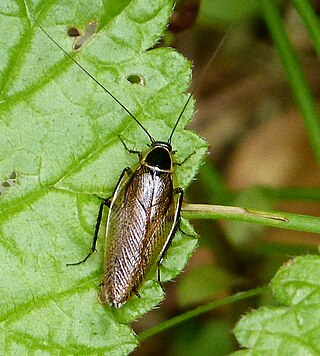
Ectobius sylvestris, known generally as the forest cockroach or lesser cockroach, is a species of cockroach in the family Ectobiidae. It is found in Europe and Northern Asia, North America, and temperate Asia.
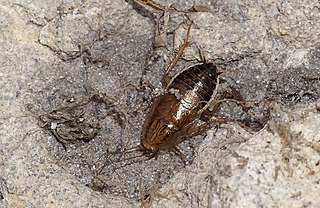
Cariblatta minima, the least yellow cockroach, is a species of cockroach in the family Ectobiidae. It is found in North America and the Caribbean.

Ischnoptera bilunata is a species of cockroach in the family Ectobiidae. It is found in North America and South America.

Latiblattella rehni, or Rehn's cockroach, is a species of cockroach in the family Ectobiidae. It is found in North America and the Caribbean.
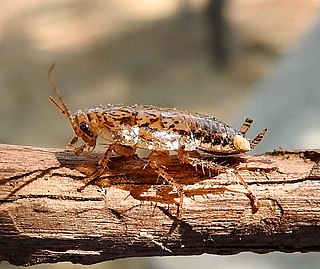
Latiblattella is a genus of cockroach in the family Ectobiidae.

Corydiinae is a subfamily of the order Blattodea (cockroaches). Many are known as sand cockroaches. The subfamily, comprising about 20 genera, contains half the genera in Corydiidae. One prominent species is the desert cockroach, Arenivaga investigata.

















